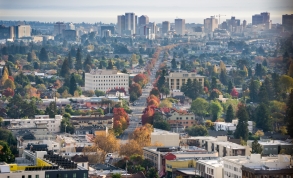Related Content

Air quality
Street trees in Lisbon, Portugal

Air quality
Runoff from stormwater is one of the main contributors of water pollution of urban areas as it contains bacteria, heavy metals, and other pollutants. Historically, grey infrastructure, pipes, gutters, and tunnels, were used to manage stormwater flow but increasingly cities are moving to green infrastructure i.e., using plant and soil systems, to absorb stormwater (United States Environmental Protection Agency [EPA], 2022a). As part of the "Green City, Clean Waters" program in Philadelphia, United States, the city is using green infrastructure to reduce stormwater and combined sewer overflows. Representative of the program is a bio-infiltration garden, implemented on the University of Villanova campus. It was constructed on a retrofitted parking area in 2001 as a research site and a life cycle assessment was conducted to assess the benefits of the rain garden. Whilst primarily designed to reduce stormwater volumes and pollution of the headwaters of the nearby Darby Creek, the rain garden provides benefits including carbon storage and sequestration, air pollution removal, energy savings and recreation opportunities.
The rapid pace of land-use changes in the United States has resulted in the degradation of natural resources including loss of biodiversity and vital ecosystem services (Flynn, 2011). Green infrastructures are increasingly implemented as solutions to protect and restore ecosystems without compromising development. The City of Philadelphia’s “Green City, Clean Waters” program was initiated to reduce combined sewer overflow in the city and to comply with the United States Clean Water Act.
Whilst the focus of green infrastructure is often on stormwater management benefits, this life-cycle assessment of a bio-infiltration garden demonstrates broader benefits including carbon footprint reduction, air and water quality improvements, energy savings and recreation opportunities, as well as considerable health impacts associated with the construction phase (Flynn, 2011). In 2001, a bio-infiltration rain garden was constructed on the Villanova University campus in Pennsylvania, built on a retrofitted traffic island with a drainage area measuring around 1.3 acres. It has an approximate footprint of 405 m2 and was originally designed to retain 2.54 cm of precipitation volume from its contributing drainage area. The drainage area was further shaped as a shallow bowl to facilitate water runoff and was equipped with water quality sampling and flow monitoring equipment which has been monitored since 2003.
Although the garden was primarily designed to reduce combined sewer overflow and reduce stormwater reaching the nearby Darby Creek, it also provides benefits beyond stormwater management (Flynn, 2011). The study undertook a life cycle assessment (LCA) to evaluate the impact of a bio-infiltration rain garden using an approach that considers all material and energy flows across the construction, operational and decommissioning phases.
The construction phase took place between August, 2nd and August 25th, 2001 and was the life cycle stage that contributed most to the environmental impact of the rain garden, due to the use of silica sand and bark mulch. Adverse health impacts related to ozone depletion, eco-toxicity, smog formation as well as respiratory illness, cancer and non-cancer illness were associated with the material used in the construction phase. The use of silica contributed particularly to the eutrophication potential, whereas bark mulch increased respiratory effects and global warming potential. The global warming potential during the construction phase totalled 4,942kg CO2 equivalent (eq.), 26kg PM2.5 eq. for the respiratory effects, 7kg nitrogen (N) eq. for the eutrophication potential.
During the operational phase which assumed a 30 year operational life, the bio-infiltration garden vegetation provided ecosystem benefits, including carbon sequestration, air pollution removal and stormwater management. This included 490kg carbon storage and 40kg of carbon sequester per year, and an annual avoided global warming potential of 1,943kg CO2eq. The annual air pollutant removal by the rain garden vegetation was 0.05kg of CO, 0.47kg of NO2, 0.88kg of O3, 0.97kg of PM10 and 0.20kg of SO2. The operation phase was further associated with avoided stormwater management, with potential to remove an annual average of 973m3 stormwater, 422kg of total suspended solids (TSS), 783kg of total dissolved solids (TDS), 2kg of total nitrogen (TN) and 1kg of total phosphorus (TP).
For the decommissioning phase two scenarios were estimated. The first one included disposal of any rain garden media and construction materials, whereas the second one was the reuse of all rain garden media. Whilst costs and labour were similar for both scenarios, the environmental and health impacts differed vastly. In the first scenario, the global warming potential totalled 51,291kg CO2 eq., respiratory effects 4.07kg PM2.5 eq., and human health cancer impacts 17,227kg benzene eq. In the second scenario, the global warming potential was estimated 134kg CO2 eq., respiratory effects 0.27kg PM2.5 eq., human health cancer impacts 0.07kg benzene eq.
The bio-infiltration garden is representative of the City of Philadelphia’s "Green City, Clean Waters" program to manage stormwater flow and to reduce combined sewer overflow events. The program began in 2011 to meet the United States Clean Water Act, which requires the city of Philadelphia to reduce at least 85% of the current water pollution levels or risk fines. It is a 25-year long-term plan ending in 2036 and includes regulations for municipalities to develop combined sewer outflow alternatives as well as studying combined sewer systems and rivers to better understand how the systems are working (Philadelphia Water Department, n.d.). The City of Philadelphia has established itself as a national leader in supporting green infrastructure. As part of the program, the city is promoting the urban environment and implementing stormwater management solutions, such as the bio-infiltration rain garden (Flynn, 2011). On the Villanova University Campus alone, there are more than 20 stormwater capture and infiltration systems to monitor and measure the quality and quantity of rainwater.
The potential benefits of implementing green infrastructure are not uniformly recognised across the US (EPA, 2022) which makes scaling up this intervention challenging. The cost of implementing green infrastructure makes the alternative grey infrastructure preferable across many municipalities in place of costlier but transformative approaches. Despite the higher implementation costs, green infrastructure is more cost-effective and delivers longer-term benefits to the environment and human health (EPA, 2022). Another barrier to scaling up is the complex legal systems on water use and water rights that vary by state. The United States Environmental Protection Agency has developed strategies for local governments to address some of these barriers for example by documenting the multiple benefits of green infrastructure.